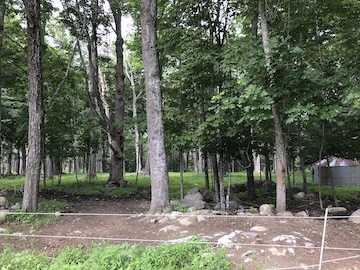By Jacki M. Perkins
The face of production farming has changed drastically in the last 100 years. We have moved away from growing our own food and have relied on others to provide for us. There has, however, been a growing interest, driven by global circumstances, in re-learning the art of the homestead. The majority of homeowners, or those aspiring to be, aren’t seeking the acreage needed to raise vast herds of livestock or grow a market garden. They often find themselves with a frustrating in-between scale. There’s no reason to despair being able to keep up with a sizable garden and instead resigning oneself to monocropping 2 acres worth of lawn. With some thought and care, a reasonable amount of livestock may be raised on limited acreage. Let’s discuss some options and things to look for when considering starting a homestead.


First of all, focus on your favorite things to eat and ways that you like to spend your time. Life is short: if you love something, then even the hardships that you inevitably encounter will be more easily embraced. If you don’t enjoy eggs, don’t get chickens. If your garden space is limited, avoid things that sprawl, like cabbage and rhubarb. Do you have trouble getting in 10,000 steps? Try raising some livestock, because there’s always fence lines to walk and maintain. Do you love baby animals? Goats or sheep often have twins or triplets.
Once you’ve decided where your interests lie, the challenge of fitting them into your particular acreage arises. For example, on 3 to 5 acres of mostly open, fairly dry grassland, a homesteader would have the immediate option of installing fences and having livestock. (Horses included — don’t let anyone tell you horses are bad for pasture. They just need to be managed differently than ruminants.) Wooded land can also be compatible with livestock. Goats and pigs can be a great option for managing the brushier sections of a woodlot, should a landowner enjoy managing timber or cutting firewood. A longer-term goal of building an orchard might appeal to someone less interested in mammals and maintaining a fence.
For those with much smaller landholdings, or pieces that are wet for a portion of the year, that can’t support larger animals, poultry can be a gratifying way to add fertility to one’s homestead. If you have open fields too small for haymaking and don’t want to commit to owning livestock, cultivating a scrumptious pollinator habitat and renting bees could be a lovely compliment to an organic garden. Planting perennial fruits and herbs can be a low-maintenance option as well. In a more heavily wooded area, cultivating mushrooms is a fascinating endeavor that doesn’t require vast tracts of land. There are also non-edible agricultural options to consider, such as cut flowers.

Pastured chickens follow other livestock to help incorporate manure. Perkins photo
For whatever you decide, MOFGA offers guidance in the form of hands-on classes, webinars and troubleshooting current issues you may be facing. Please visit our website, and/or contact our community education department for courses of interest. I will leave you all with one last piece of advice: never let the fear of failure stop you from starting.
Jacki M. Perkins is MOFGA’s organic dairy and livestock specialist. You can contact her at [email protected].
